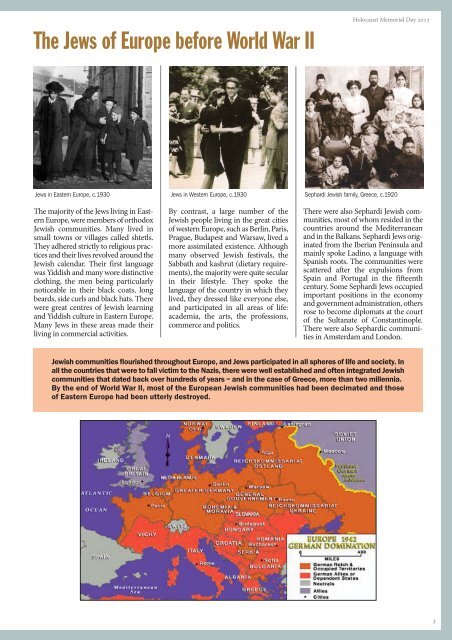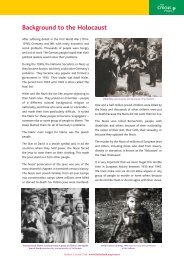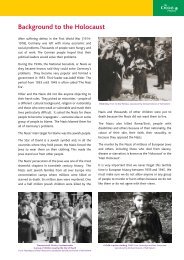19505_HMD_Cover:Layout 1 - Holocaust Education Trust Ireland
19505_HMD_Cover:Layout 1 - Holocaust Education Trust Ireland
19505_HMD_Cover:Layout 1 - Holocaust Education Trust Ireland
You also want an ePaper? Increase the reach of your titles
YUMPU automatically turns print PDFs into web optimized ePapers that Google loves.
The Jews of Europe before World War II<br />
<strong>Holocaust</strong> Memorial Day 2013<br />
Jews in Eastern Europe, c.1930 Jews in Western Europe, c.1930 Sephardi Jewish family, Greece, c.1920<br />
The majority of the Jews living in Eastern<br />
Europe, were members of orthodox<br />
Jewish communities. Many lived in<br />
small towns or villages called shtetls.<br />
They adhered strictly to religious practices<br />
and their lives revolved around the<br />
Jewish calendar. Their first language<br />
was Yiddish and many wore distinctive<br />
clothing, the men being particularly<br />
noticeable in their black coats, long<br />
beards, side curls and black hats. There<br />
were great centres of Jewish learning<br />
and Yiddish culture in Eastern Europe.<br />
Many Jews in these areas made their<br />
living in commercial activities.<br />
By contrast, a large number of the<br />
Jewish people living in the great cities<br />
of western Europe, such as Berlin, Paris,<br />
Prague, Budapest and Warsaw, lived a<br />
more assimilated existence. Although<br />
many observed Jewish festivals, the<br />
Sabbath and kashrut (dietary requirements),<br />
the majority were quite secular<br />
in their lifestyle. They spoke the<br />
language of the country in which they<br />
lived, they dressed like everyone else,<br />
and participated in all areas of life:<br />
academia, the arts, the professions,<br />
commerce and politics.<br />
There were also Sephardi Jewish communities,<br />
most of whom resided in the<br />
countries around the Mediterranean<br />
and in the Balkans. Sephardi Jews originated<br />
from the Iberian Peninsula and<br />
mainly spoke Ladino, a language with<br />
Spanish roots. The communities were<br />
scattered after the expulsions from<br />
Spain and Portugal in the fifteenth<br />
century. Some Sephardi Jews occupied<br />
important positions in the economy<br />
and government administration, others<br />
rose to become diplomats at the court<br />
of the Sultanate of Constantinople.<br />
There were also Sephardic communities<br />
in Amsterdam and London.<br />
Jewish communities flourished throughout Europe, and Jews participated in all spheres of life and society. In<br />
all the countries that were to fall victim to the Nazis, there were well established and often integrated Jewish<br />
communities that dated back over hundreds of years – and in the case of Greece, more than two millennia.<br />
By the end of World War II, most of the European Jewish communities had been decimated and those<br />
of Eastern Europe had been utterly destroyed.<br />
3
















